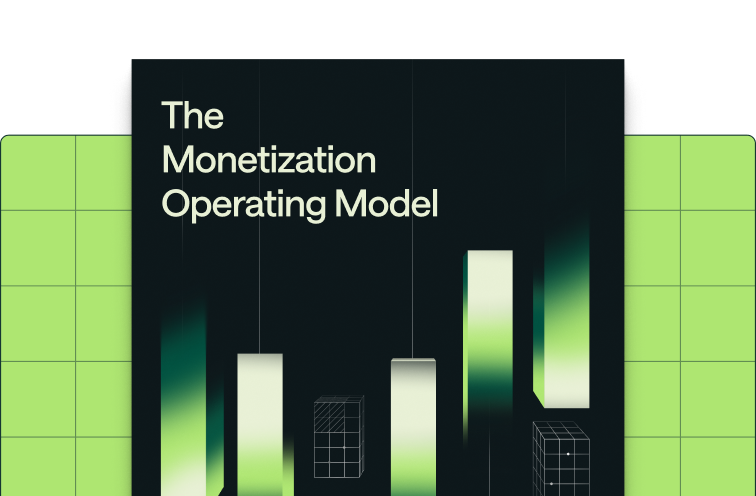Share
What is outcome-based pricing?
Outcome-based pricing is a pricing approach where you charge customers based on the business results you deliver rather than features they access or how much they use your product.
Instead of paying for software subscriptions or consulting hours, customers pay based on actual outcomes: revenue you generate, costs you save, performance you improve, or specific business goals you help them meet.
This pricing approach shifts payment from inputs to outputs. You create direct alignment between your revenue and customer value. When you deliver great results, you earn higher fees than traditional pricing allows.
When results fall short, your revenue reflects that reality. This alignment works best when you can clearly measure and prove the value you deliver.
How outcome-based pricing works
Outcome-based pricing needs three things:
- Measurable outcomes
- Ways to prove you caused those results
- Pricing formulas that turn results into payments.
Your outcomes must be specific and trackable. For example, revenue increases, cost reductions, efficiency improvements, and performance gains all work when you can track them with hard data. Vague outcomes like "improved satisfaction" or "better performance" don't work because you can't measure them clearly.
You need ways to prove your solution caused the measured outcomes. This becomes critical when customers use multiple tools or when results have different contributing factors. Strong proof requires clear baseline measurements, tracking systems that monitor changes over time, and methods that isolate your solution's impact from other variables.
Your pricing formulas convert measured outcomes into payment amounts. These might use flat fees per milestone achieved, percentages of savings generated, or tiered rates based on performance levels. The formulas must be clear, fair, and agreed upon before you start.
This approach works best when outcomes are directly connected to your solution, valuable enough to justify pricing based on results, and measurable through reliable data sources that both parties trust.
{{widget-monetization-whitepaper}}Types of outcome-based pricing models
Outcome-based pricing ties what customers pay to the results your product or service delivers. Instead of billing for access or usage, these models link pricing to tangible business value—like revenue generated, milestones hit, or performance improvements.
Here are four common types of outcome-based pricing models and how they work in practice.
Performance fee models
Performance fee models charge based on specific operational improvements your solution delivers. These work when you can measure clear performance gains like increased conversion rates, faster processing times, or improved accuracy levels.
For example, Riskified uses this approach for fraud prevention, charging merchants only for transactions it approves and guarantees against chargebacks.
Riskified's fees align directly with successful fraud prevention rather than charging for all transactions processed. Customer support platforms increasingly charge based on the number of tickets their AI successfully resolves, linking payment to actual problem-solving outcomes.
Revenue share models
Revenue share models take a percentage of the incremental revenue your solution generates. This works when there's a clear connection between your product and customer revenue increases.
PayPal pioneered this approach in payment processing, charging merchants a percentage of each transaction processed rather than flat fees.
This aligns PayPal's revenue with merchant sales volume and success. Referral management platforms charge based on annual recurring revenue (ARR) generated from referral programs they manage, ensuring they only profit when their referral systems actually drive new customer revenue.
Success milestone models
Success milestone models trigger payments when customers achieve specific business goals. This approach works for solutions where success can be defined by discrete, measurable events.
Recruitment platforms charge per successful hire or candidate placement rather than monthly subscriptions. You need clear milestone definitions and measurement criteria that both parties can verify.
Hybrid models
Hybrid models combine base fees with outcome-based components. This approach balances revenue stability for you with outcome alignment for customers.
Consulting firms often use hybrid approaches that combine monthly retainers for guaranteed access with additional fees based on specific results achieved. Hybrid models work well for complex solutions or long-term partnerships where you need some revenue predictability.
What you need to make outcome-based pricing work
Outcome-based pricing needs systems that can track customer business results, prove those results came from your solution, and calculate payments based on variable achievements.
Traditional billing platforms handle fixed subscription fees and simple usage metrics, but they can have difficulty managing the complex data integrations and dynamic calculations that outcome-based models need.
Outcome-based pricing depends on several connected systems:
- Real-time result tracking: Integrations with customer CRM systems, operations platforms, and analytics tools to monitor revenue changes, efficiency gains, and performance improvements automatically
- Ways to prove impact: Baseline measurements, continuous tracking, and analysis to prove your solution caused measured outcomes rather than external factors
- Variable billing calculations: Automated systems that pull outcome data, apply pricing formulas, and generate invoices based on results achieved rather than fixed subscription amounts
- Transparent reporting: Customer dashboards that show outcome measurements, how you proved impact, and fee calculations in formats customers can audit and verify
- Performance-based revenue recognition: Accounting systems that handle irregular payments triggered by outcome achievement rather than calendar schedules
Implementing outcome-based pricing adds complexity, but can also builds trust.
Customers can see exactly how fees connect to the value delivered, making pricing feel fairer and more aligned. To make this work at scale, companies often adopt a flexible billing infrastructure that can integrate with multiple data sources, automate pricing logic, and surface clear reporting across customer accounts.
Common challenges with outcome-based pricing
While outcome-based pricing offers significant benefits, implementing it successfully means addressing several common challenges that can derail projects or create ongoing operational problems.
Outcome measurement complexity
Measuring outcomes represents the primary challenge for most companies. Establishing clear baselines, tracking results accurately, and connecting outcomes to specific solutions requires sophisticated systems and processes. Start with simple, easily measured outcomes before building complexity.
Cash flow unpredictability
Cash flow unpredictability concerns many vendors since outcome-based revenue may not follow traditional patterns. Hybrid models that combine base fees with outcome bonuses can provide stability while maintaining outcome alignment. Historical outcome data often provides more reliable forecasting than subscription renewal assumptions.
Customer gaming attempts
Customer gaming attempts occur when outcome definitions allow manipulation. Use multiple metrics rather than single measurements, establish minimum performance thresholds, and include clear measurement criteria in contracts. Third-party validation can reduce disputes over outcome achievement.
Attribution disputes
Attribution disputes arise when outcomes have multiple contributing factors. Clear baseline measurements, documented methodologies, and formal dispute resolution processes help manage these challenges. Focus on outcomes where your solution's impact is obvious and measurable.
Outcome-based pricing is the next frontier in software monetization
As software becomes more intelligent and integrated into core business operations, pricing models need to reflect the value they actually create. Outcome-based pricing moves the conversation from features and access to impact and results. It’s a powerful model—but only if your billing systems can support it.
Metronome gives modern software companies the tools to experiment with and scale outcome-based models, from flexible pricing logic to audit-ready reporting. If you’re exploring what this shift means for your business, don’t miss our new guide.
Outcome-based pricing frequently asked questions (FAQs)
How does outcome-based pricing differ from usage-based pricing?
Usage-based pricing charges for consumption, like API calls or data processed. Outcome-based pricing charges for business results like revenue generated or costs saved. Usage measures activity while outcomes measure business value.
What outcomes work best for pricing models?
Effective outcomes are specific, measurable, connected to your solution, and valuable to customers. Revenue increases, cost savings, efficiency improvements, and performance gains work when properly tracked and verified.
How do you prevent outcome measurement disputes?
Use clear definitions, transparent measurement methods, and formal dispute resolution processes. Multiple metrics, baseline requirements, and third-party validation reduce dispute risk while maintaining outcome alignment.
Can small companies use outcome-based pricing?
Yes, but start simple with easily measured outcomes. Use hybrid models for cash flow stability and build measurement infrastructure gradually. Smaller companies often have advantages in customer relationships and pricing flexibility.
What infrastructure do you need?
You need outcome tracking systems, ways to prove impact, flexible billing platforms, customer data integration, transparent reporting, and revenue recognition that handles variable, performance-based income streams.
{{widget-monetization-whitepaper}}








%2520(1)%2520(1).png)

.avif)